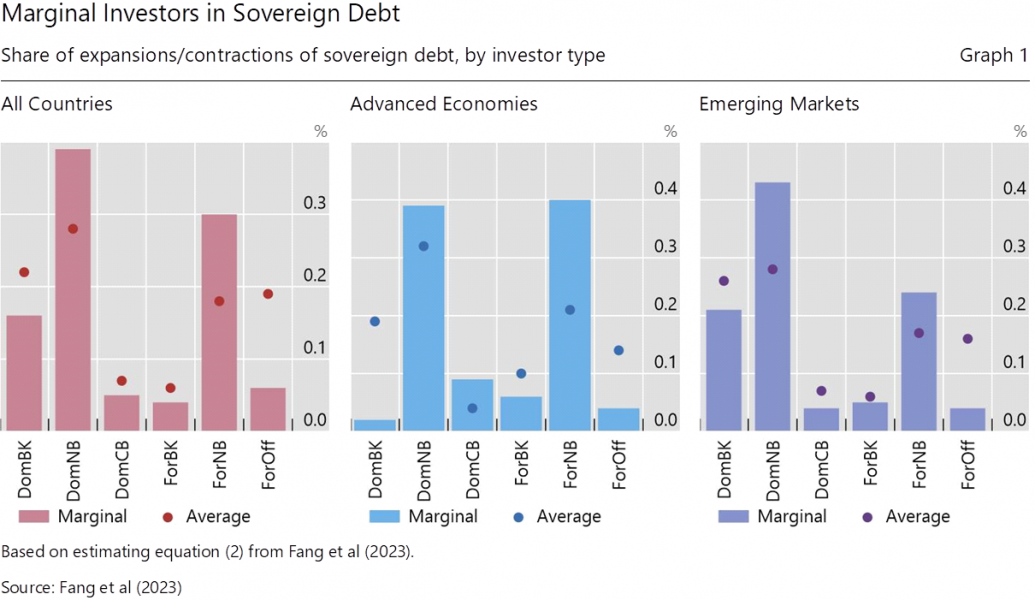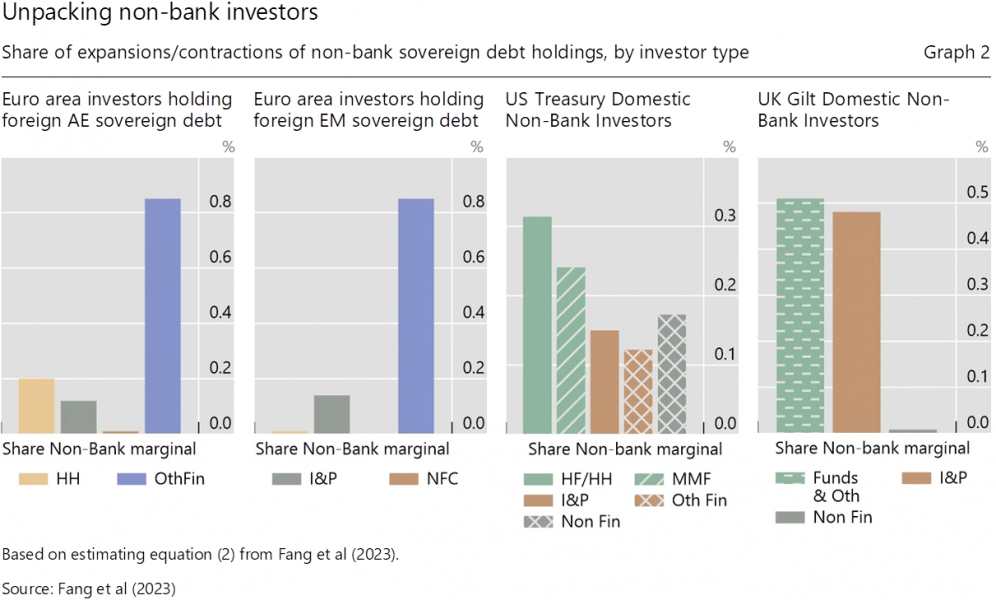

The ability of a sovereign to borrow – and at what price it can do so – depends on the investors that purchase its debt. This brief examines the composition of sovereign debt investors globally and sheds light on how it affects sovereign borrowing. Non-bank investors are the most marginal for sovereign debt, meaning their holdings expand and contract the most when total sovereign debt expands and contracts. They are also the most responsive to changes in sovereign yields. For emerging markets, these two facts imply that sovereign borrowing costs rise by more when non-bank investors are not present.
Sovereign borrowing can help buffer the economy from bad macroeconomic shocks. The Covid-19 pandemic serves as a perfect illustration, as governments increased their spending and debt issuance in order to address the attendant challenges. However, that increased indebtedness can make a country vulnerable to financial distress. As policy rates rise and financial conditions tighten, sovereigns may face challenges servicing and rolling over this debt. But their ability to borrow and the rate offered on their debt will depend on which investors are willing to buy and how those investors respond to the price.
This brief summarizes our recent research (Fang, Hardy, and Lewis (2023)), where we study the composition of investors in the sovereign debt market globally and how it affects sovereign borrowing costs.
First, we construct a dataset of the investors of sovereign debt across 95 countries and spanning over 20 years, building from previous efforts (Arslanalp and Tsuda (2014a, 2014b) and Arslanalp and Sunder-Plassmann (2022)). This dataset decomposes the outstanding debt of each sovereign into six types of investors that hold that debt: domestic and foreign investors that are banks, private non-banks, or official sector lenders (i.e. the domestic central bank, the IMF, etc.).
Typically, research on sovereign debt focuses on or assumes a specific type of investor. For example, the literature on sovereign default, particularly in emerging markets, focuses on foreign investors, typically modelled as a foreign bank (Eaton and Gersovitz (1981); Arellano (2008)). The sovereign-bank nexus literature focuses on domestic banks (Fahri and Tirole (2018); Gennaioli et al (2014)). And a separate literature seeks to understand official sector accumulation of foreign reserves (Ghosh, Ostry, and Tsangarides (2017); Bianchi, Hatchondo, and Martinez (2018)). We use our dataset to jointly study the behavior and importance of these different investor groups and examine how the composition of the sovereign’s investor base matters.
Second, we analyze which type of investor is the most marginal – that is, when sovereign debt increases, for which investor does holdings of sovereign debt increase the most. This analysis tells us which investors are the most active players in the sovereign debt market and thus absorb net increases in debt issuance.
Third, we examine how responsive each investor group is to changes in the yield on sovereign debt. This helps us understand which investors the sovereign can most readily attract by increasing the price they offer on their debt.
Lastly, we combine these results to show how the composition of investors affects borrowing costs of the sovereign.
On average, non-banks are the most marginal investor in sovereign debt. Despite holding only 46% of the total outstanding sovereign debt on average, non-banks’ holdings account for nearly 70% of the increase (or decrease) in sovereign debt (Graph 1). The prominence is common across both advanced and emerging markets, both within the set of domestic investors and across foreign investors.

Non-banks are a large and very heterogeneous group of investors. They include money market funds, hedge funds, mutual funds, insurance companies, pension funds, and other non-bank financial companies, as well as non-financial investors such as non-financial corporations and households. To unpack this group, we use granular data on sovereign debt investors from the Euro Area, US, and UK. From the Euro area, we examine investors based in the Euro area, and their holdings of sovereign debt outside the Euro area (so, investment by foreign non-banks). For the US and UK, we examine holders of US Treasuries and UK Gilts, respectively, breaking down domestic non-banks. These datasets have more detail on non-bank investors but are limited in their coverage compared to our full data.
Across each of these datasets, the dynamics of non-bank investment in sovereign debt is driven primarily by investment funds. For the Euro area investors, investment funds account for over 80% of the variation in sovereign debt holdings of non-banks located in the euro area, either that of advanced economy or emerging market sovereigns (Graph 2, first two panels, purple bars). In the US, money market funds play a large role, and along with hedge funds account for over half of the variation on non-bank treasury holdings (third panel, green bars). In the UK, investment funds account for about half while insurance companies and pension funds account for the other half (fourth panel, green and brown bars). The large influence of the Insurance and Pension Sector reflects the large share of Gilts they hold. Overall, the low variation compared to size of holdings in both the US (43% of total) and UK (81% of total) are consistent with the typical buy and hold strategies of these investors leading them to be more stable.

Given these findings for who holds sovereign debt, we next consider why this composition matters to borrowers. To do this, we first consider how responsive each investor is to the yield on sovereign debt. Yields (and prices) for government bonds are determined by both supply from sovereign bond issuers and demand from sovereign bond investors. One challenge then is to determine how the investor (demand) side changes when the yield changes, holding debt supply constant. We adapt an approach pioneered by Koijen and Yogo (2019,2020) in order to get clean estimates of yield changes that are exogenous to the investors. For this analysis, we focus on emerging market sovereign debt.
Our estimates provide striking results that again point to the importance of non-bank investors. Specifically, for both emerging markets and advanced economies, non-bank investors are the creditor group most responsive to changes in yields, especially foreign non-bank investors. In response to a 1 percent increase in yield, domestic non-banks increase their debt holding by 23% while domestic banks do so by 12%. Similarly, among the foreign investors, foreign non-banks are the most responsive as they increase holdings by 38% for a 1 percent increase of yield.
We combine our previous results to assess what these estimates imply for the sovereign borrower. We ask how much the financing cost would increase for a hypothetical debt increase. Our estimates show that a 10% increase in debt corresponds to a 6.7% increase in yield for the average emerging market borrower. However, if non-bank investors are not present and borrowers must borrow from banks, the same 10% increase in debt corresponds to a substantially higher 9.1% increase in yield. Thus, emerging market sovereigns appear highly exposed to the availability of non-bank investor funding.
Emerging market sovereign investors are highly vulnerable to the presence or absence of non-bank investors. These investors tend to pick up a greater proportion of the expansions in sovereign debt and are more price responsive than other investors. This means that sovereigns need to increase the return they offer on their debt by less in order to attract non-banks to hold that debt compared to other investors. With a higher share of non-banks in their investor pool, sovereigns may be able to increase their debt while limiting the costs. Thus, the behavior of non-bank investors is crucial for understanding sovereign debt sustainability. This finding does not imply that it would be optimal for sovereigns to have only non-banks in their investor pool. Rather, sovereigns would likely be well served by cultivating a diverse set of investors, one that includes domestic and foreign non-bank investors. It could be the case that non-bank investors exit the market quicker when global markets see a downturn or when the domestic sovereign approaches a crisis. Thus, their provision of credit could potentially dry up faster than other investors, and at the exact time that the sovereign needs to raise funds. This trade-off deserves attention in future research, especially with more granular data on non-banks. As financial conditions continue to tighten, sovereigns will face difficult questions regarding their debt. Both advanced and emerging market sovereigns will need to monitor their debt issuance closely. Paying attention to the identities of their investors will give them valuable information about how costly it may be to raise new debt.
Arellano, C (2008): “Default risk and income fluctuations in emerging market economies”, American Economic Review, vol 98 (3), pp 690-712.
Arslanalp, S and L Sunder-Plassman (2022): “Sovereign Debt Repatriation During Crises”, IMF Working Paper No 2022/077.
Arslanalp, S and T Tsuda (2014a): “Tracking global demand for advanced economy sovereign debt”, IMF Economic Review, vol 62 (3), pp 430-464.
Arslanalp, S and T Tsuda (2014b): “Tracking global demand for emerging market sovereign debt”, IMF Working Paper No 14/39.
Bianchi, J, J Hatchondo and L Martinez (2018): “International reserves and rollover risk”, American Economic Review, vol 108 (9), pp 2629-2670.
Eaton, J and M Gersovitz (1981): “Debt with potential repudiation: theoretical and empirical analysis”, Review of Economic Studies, vol 48 (2), pp 289-309.
Fahri, E, and J Tirole (2018): “Deadly embrace: sovereign and financial balance sheets doom loops”, Review of Economic Studies, vol 85 (3), pp 1781-1823.
Fang, X, B Hardy and K Lewis (2023): “Who holds sovereign debt and why it matters”, NBER Working Paper No 30087, BIS Working Paper No 1099.
Gennaioli, N, A Martin and S Rossi (2014): “Sovereign default, domestic banks, and financial institutions”, Journal of Finance, vol 69 (2), 819-866.
Ghosh, A, J Ostry and C Tsangarides (2017): “Shifting motives: explaining the buildup of reserves in emerging markets since the 1980s”, IMF Economic Review, vol 65, pp 308-364.
Koijen, R, and M Yogo (2019): “A demand system approach to asset pricing”, Journal of Political Economy, vol 127 (4), pp 1475–1515.
Koijen, R, and M Yogo (2020): “Exchange rates and asset prices in a global demand system”, NBER Working Paper No 27342.